Topic 12: Classifying Organisms + Productivity in the Ocean
1/70
There's no tags or description
Looks like no tags are added yet.
Name | Mastery | Learn | Test | Matching | Spaced |
|---|
No study sessions yet.
71 Terms
3 general categories for marine organisms (based on how it moves and where it lives)
Plankton (DRIFTERS)
Nekton (SWIMMERS)
Benthos (BOTTOM DWELLERS)
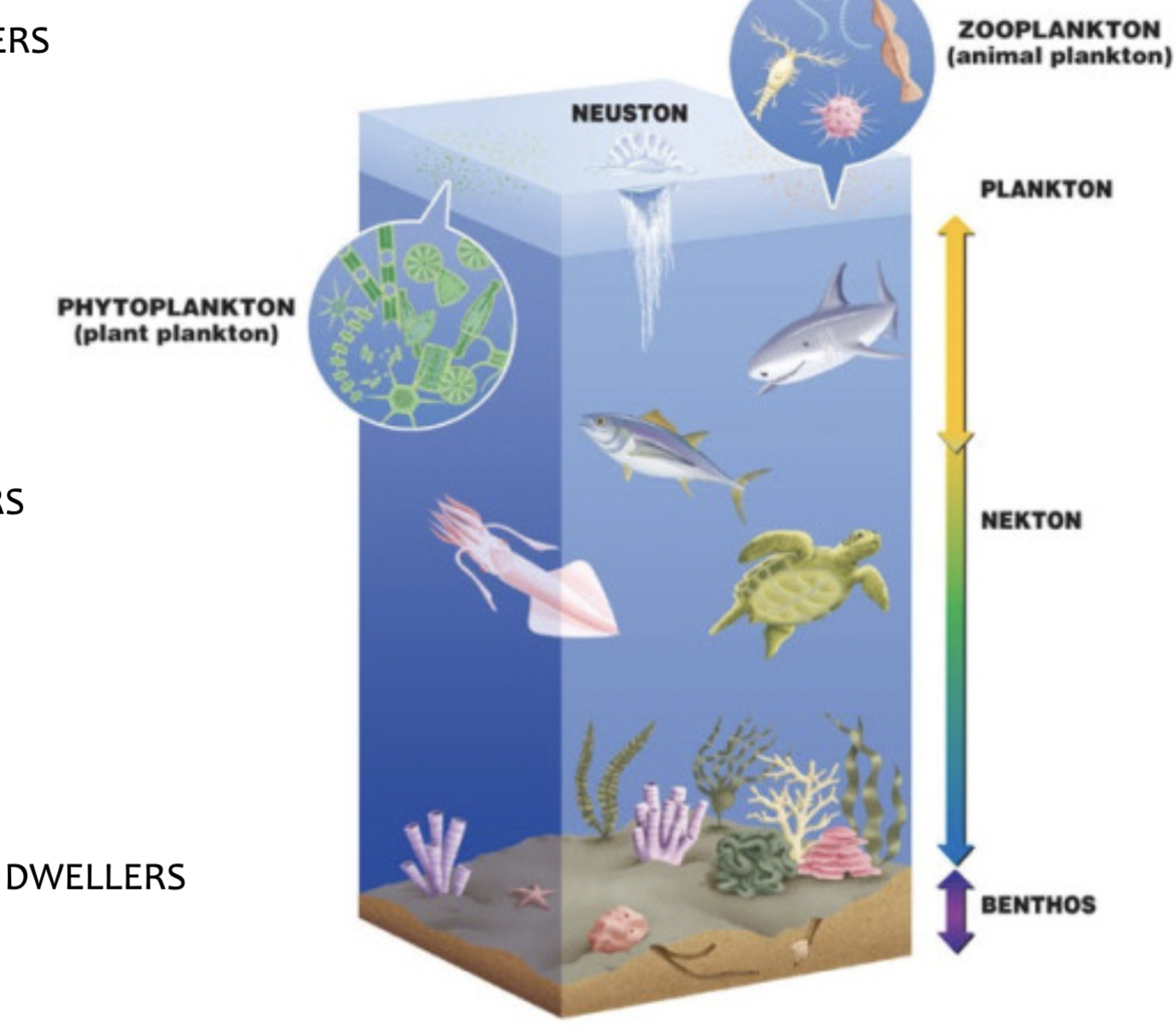
Plankton
Tiny organisms that drift with ocean currents and represent most of Earth’s biomass (one plankter = individual)
Types of plankton
Phytoplankton
Zooplankton
Holoplankton
Meroplankton
Phytoplankton
Autotrophic plankton that produce their own food via photosynthesis
Zooplankton
Heterotrophic plankton that cannot produce their own food – need to ‘eat’ something
Holoplankton
Organisms that spend their entire lives as plankton
Meroplankton
Organisms that spend their juvenile or larval stages as plankton (eg - squid)
Nekton
All animals capable of moving independently of ocean currents by swimming (or other means of propulsion)
Benthos
All animals living near, on or in the ocean floor (at all water depths)
Epifaunal
Organisms living ON the sediment
Infaunal
Organisms living IN the sediment (i.e burrowers)
Nekobenthos
Organisms swimming just ABOVE the bottom
3 Divisions of the marine environment based on sunlight
Euphotic zone
Disphotic zone
Aphotic zone
Euphotic zone
Enough sunlight for photosynthesis, where the bulk of biological productivity in the ocean occurs
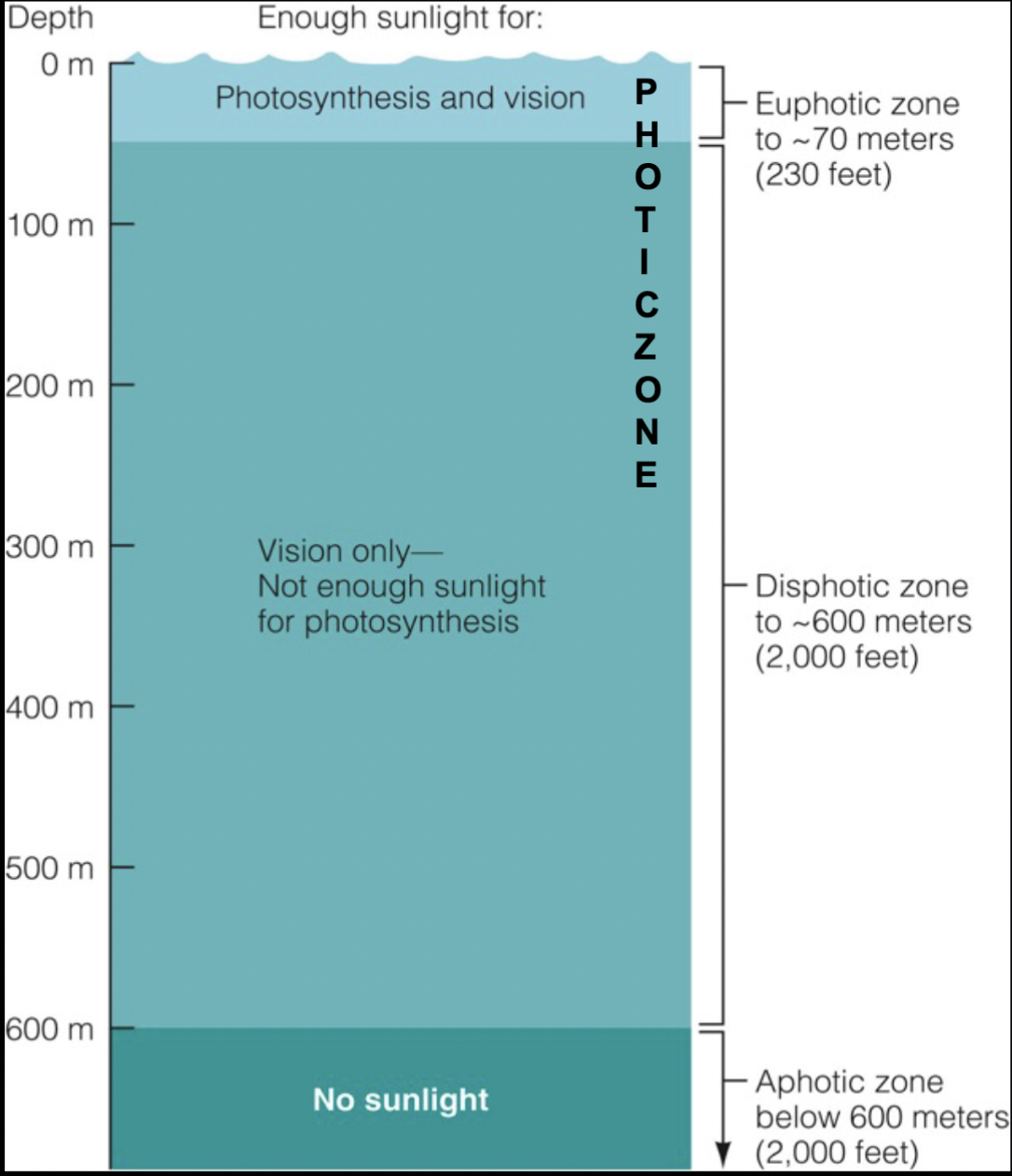
Disphotic zone
Enough sunlight for vision but not photosynthesis
Aphotic zone
No sunlig
5 Divisions of the marine environment based on depth (pelagic zones)
Epipelagic
Mesopelagic
Bathypelagic
Abyssopelagic
Hadopelagic
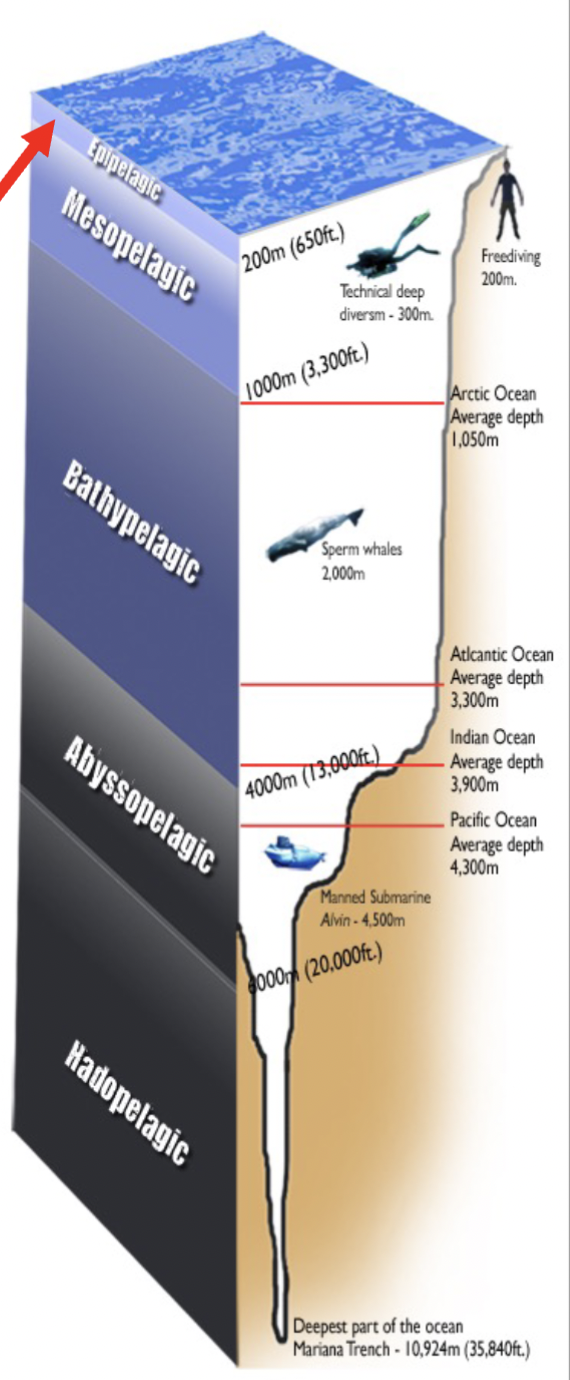
Epipelagic
Highest zone, light present and high oxygen levels
Mesopelagic
Twilight zone, very little light, low oxygen levels
Bathypelagic + Abyssopelagic
Dark, organisms create their own light (eg –bioluminescence), high pressure, live on detritus
3 Divisions of the benthic (ocean floor) environment based on depth
Intertidal
Sublittoral
Bathyl
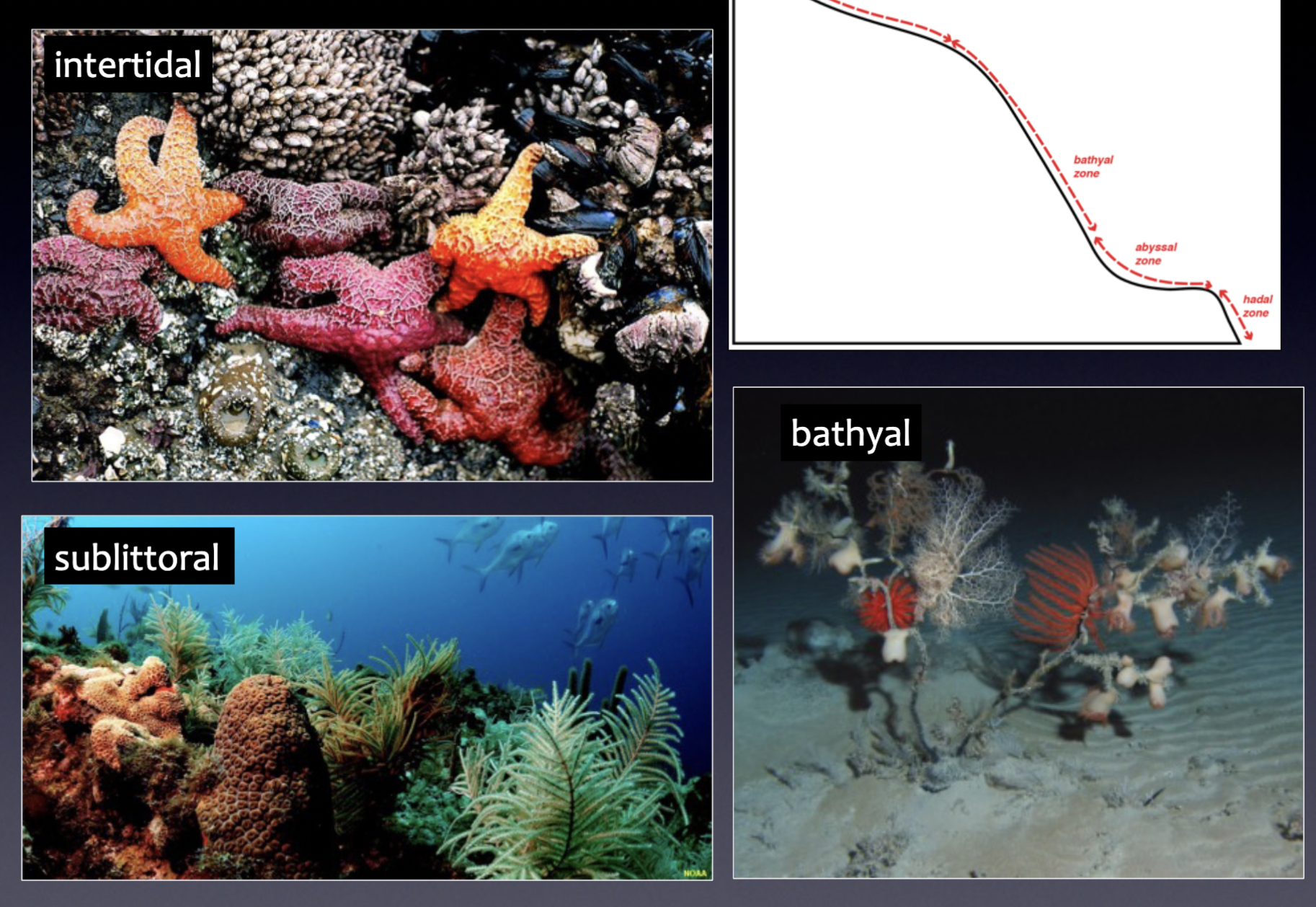
Primary Productivity
The rate at which organisms store energy through the formation of organic matter (carbon-based compounds) from inorganic carbon (carbon dioxide); aka rate of biomass formation
Photosynthesis
Chemical reaction where organisms utilize sun’s energy to produce carbohydrates
Units of primary productivity
expressed as gC/m²/yr
grams of carbon bound into organic material per square metre of ocean surface area per year
carbon “fixed” in organic matter in the ocean
3 factors affecting primary productivity
Solar radiation
Nutrient availability
Water temperature
Limiting factors
A biotic or abiotic factor that restricts the number or production of an organism (can be too much or too little of that factor)
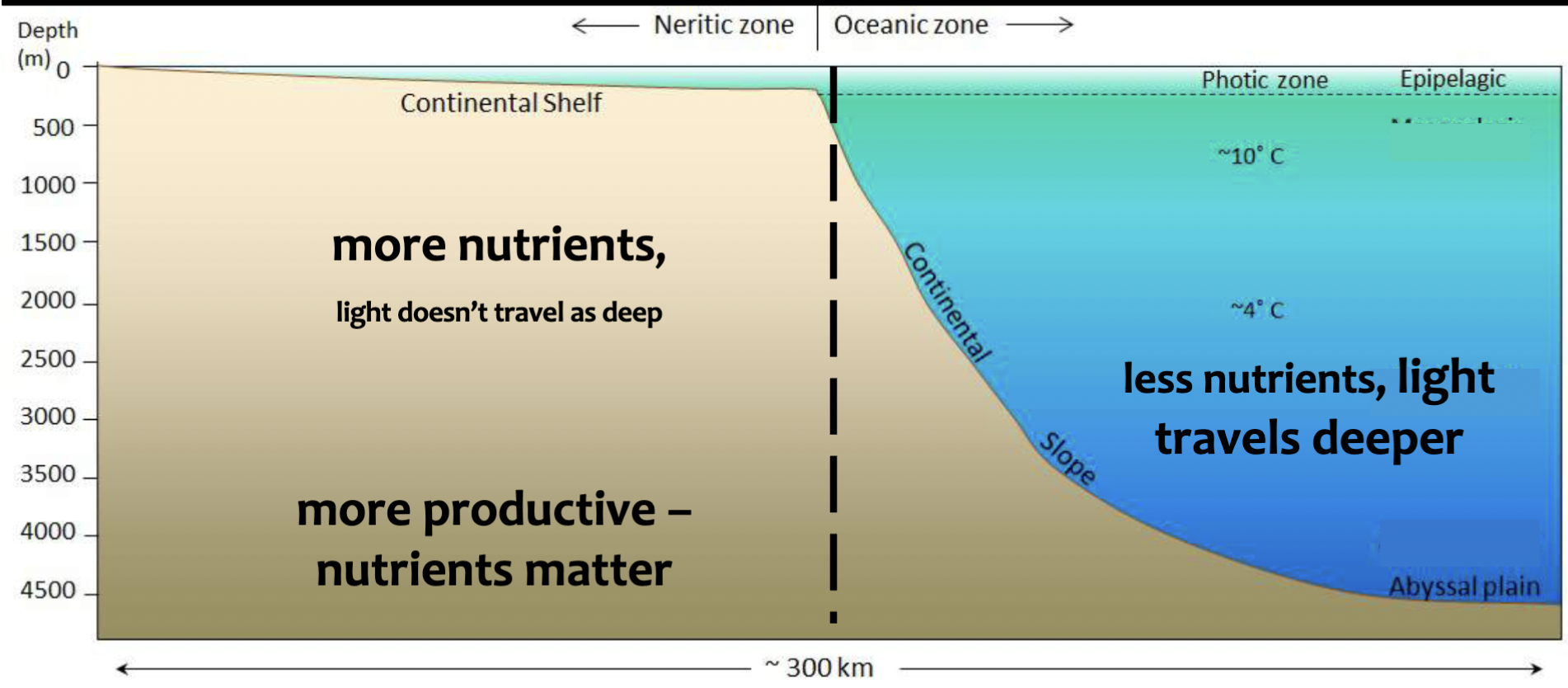
Why is there very little photosynthesis below 100 m
Phytoplankton like to absorb red light wavelengths, so they stay near the ocean’s surface
Gross primary productivity
Total amount of organic material created by the producers
Net production (gross productivity – respiration)
Since primary producers consume a portion of this organic matter themselves through respiration, the total amount that is left to support the consumers is the net production
Compensation depth for photosynthesis
Depth where gross photosynthesis is balanced by respiration
Water depth at which light is limited so that net photosynthesis = zero
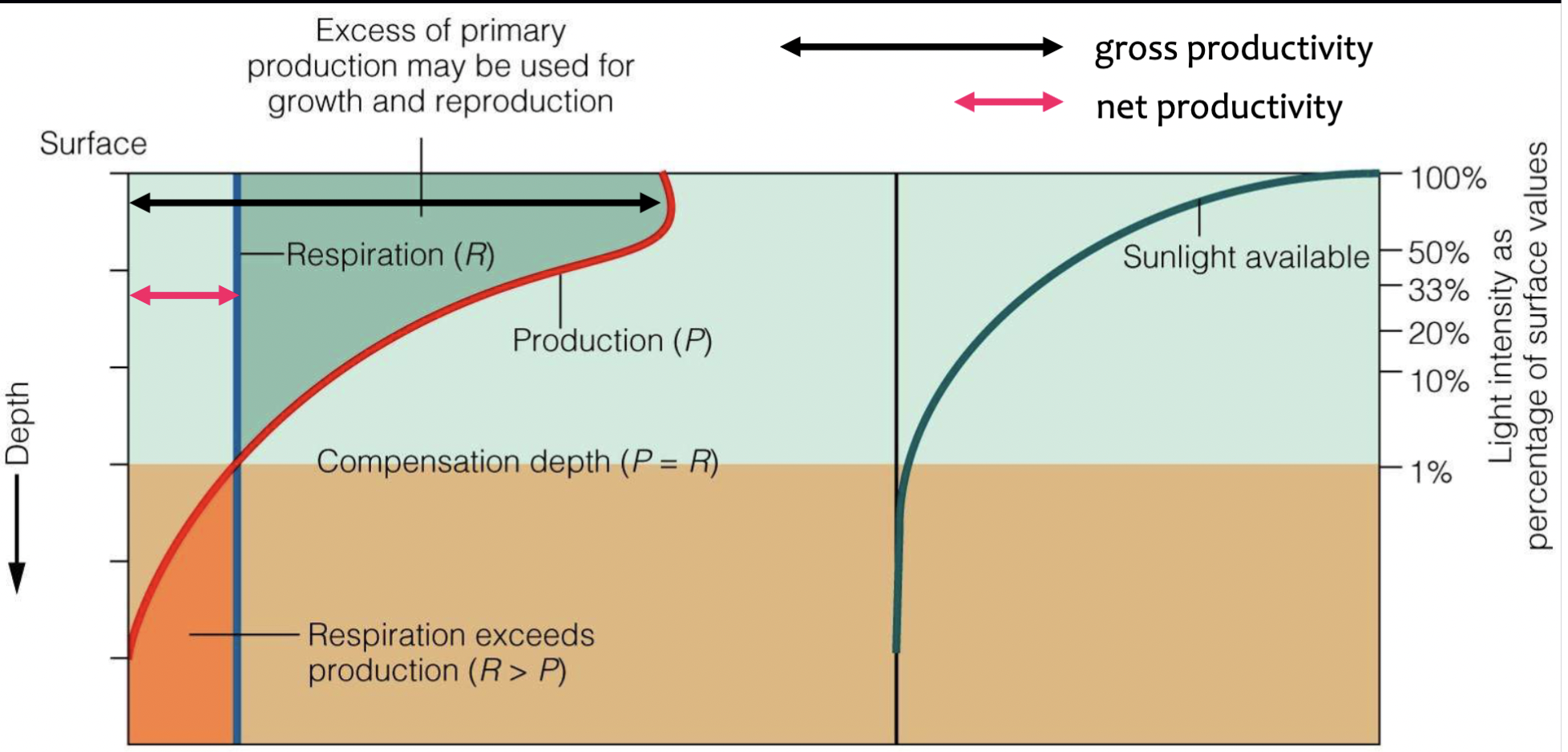
Biogeochemical cycle
Cycle by which nutrients are transferred through the land and ocean
Uses of phosphorous (P)
Required for DNA, RNA and energy transfer (ATP)
Uses of nitrogen (N)
Not used directly, need nitrogen fixation into nitrate (NO3)
Need to support photosynthesis; supports aquatic plant growth, protein synthesis

Availability of nitrate (NO3) in the open ocean
Increases with depth; upwelling can bring deep water nutrients to surface
Redfield Ratio (of nutrients)
106 carbon: 16 nitrogen: 1 phosphorus
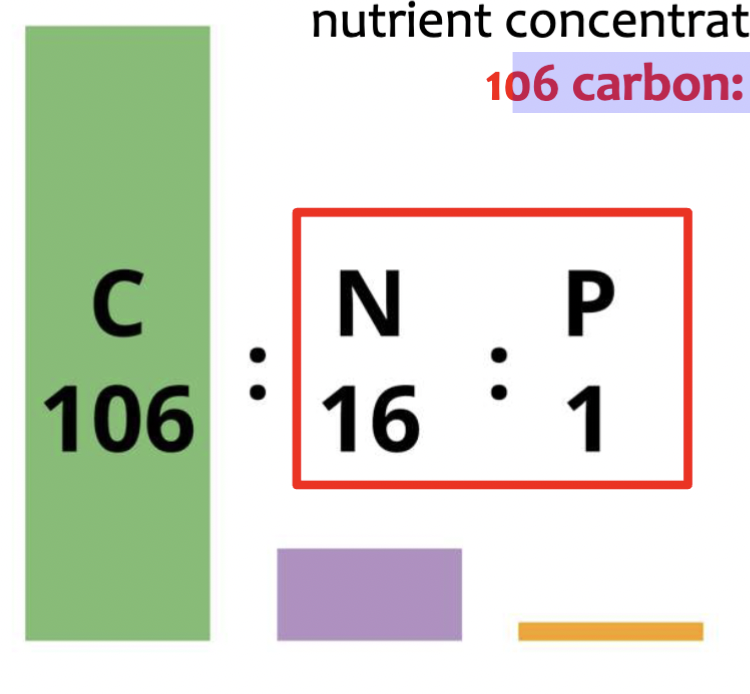
Why the Redfield Ratio exists
Organic processes which tend in some way to control the proportions of these elements in the water
Diazotrophs
Organisms capable of marine N-fixation
Eutrophication
The excessive loading of water with nutrients (N and P) resulting in increased biomass production
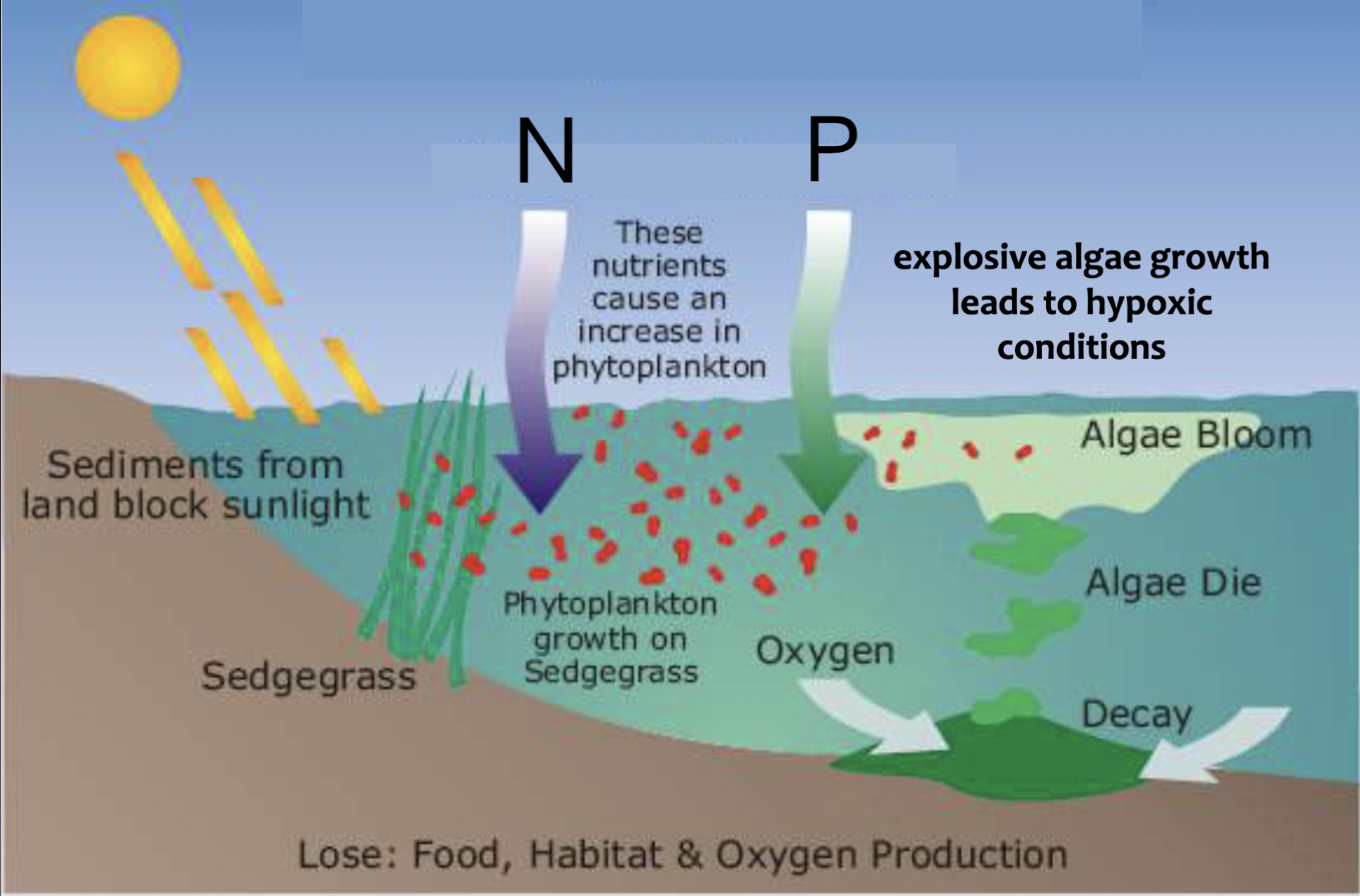
5 Consequences of eutrophication
Increased oxygen consumption and therefore O2 depletion (anoxia)
Algal blooms
Effects on biodiversity and food webs
Impacts food security and ecosystem health
Impacts on humans: disruptions in tourism, fisheries and health industries
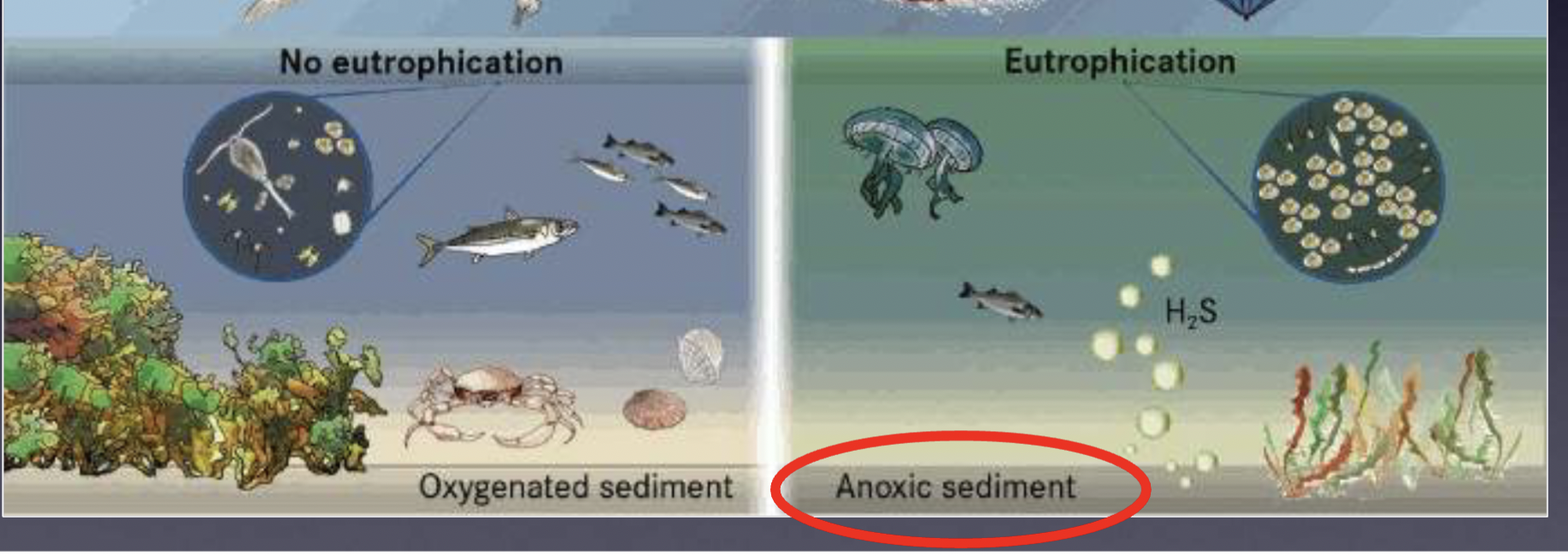
HNLC (Fe limitation)
High nutrient, low chlorophyll areas where bioavailable Fe is scarce
Functions of Fe (iron)
Is an essential micronutrient that controls phytoplankton productivity (can be a limiting nutrient)
High reactivity of Fe2+ with O
Low solubility of Fe3+
Sources of Fe
Dust is a major external source
Riverine sources and glacial sources at continental margins
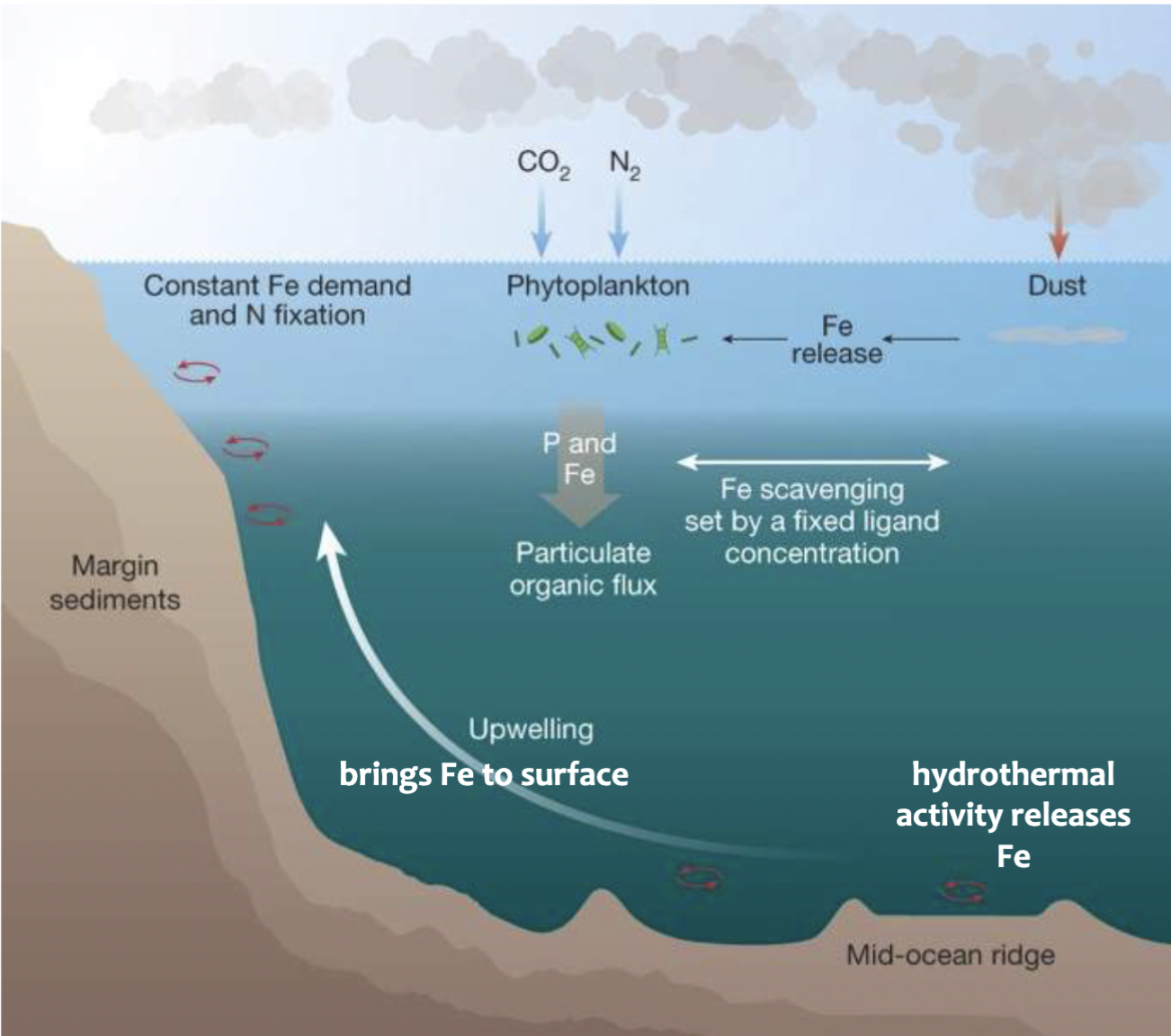
Carbon Dioxide Removal (CDR) technique
Can artificially add Fe to the ocean’s surface to stimulate growth of phytoplankton
3 categories of organisms in an ecosystem
producers (autotrophic)
consumers (heterotrophic; herbivores, carnivores, and omnivores)
decomposers (break down organic compounds – dead, dying, and waste products)
Energy flow in marine ecosystems
Is unidirectional, flows from autotrophs (primary producers) upwards— energy is transferred up to higher trophic levels (energy lost as you move up)
5 Trophic levels
Primary producer
Primary consumer
Secondary consumer
Tertiary consumer
Apex predator
4 reasons why phytoplankton are important
Their huge population comprises 90 to 96% of surface ocean’s carbohydrates
Make huge contributions to food webs
Very important for productivity
Producers of atmospheric oxygen
3 Types of phytoplankton
Coccolithophores
Diatoms
Dinoflagellates
Coccolithophores
Phytoplankton covered with small plates (coccoliths) made of CaCO3
Live in moderate to low nutrient conditions
Tend to live in waters that are brightly lit and temperate to warmer
Causes of phytoplankton blooms (exponential growth)
Favourable winds and currents
‘Overfeeding’
High water conditions
Seasonal
Latitude dependent
Dinoflagellates
Single-celled phytoplankton, typically microscopic
Internal skeleton made of cellulose and siliceous (SiO2)
Variety of shapes and sizes
Have flagella that allows the organism to adjust its orientation and vertical position in the water – best use of light available, obtain nutrients
Can be bioluminescent
Red tides and harmful algal blooms (HAB)
Dinoflagellate explosion
Red because dinoflagellates contain a red pigment
Can be toxic or non-toxic
Deplete water of oxygen
Diatoms
Some of the most productive photosynthesizers
Their presence indicates high nutrient conditions
Component of siliceous ooze
Tests (shells) made of silica
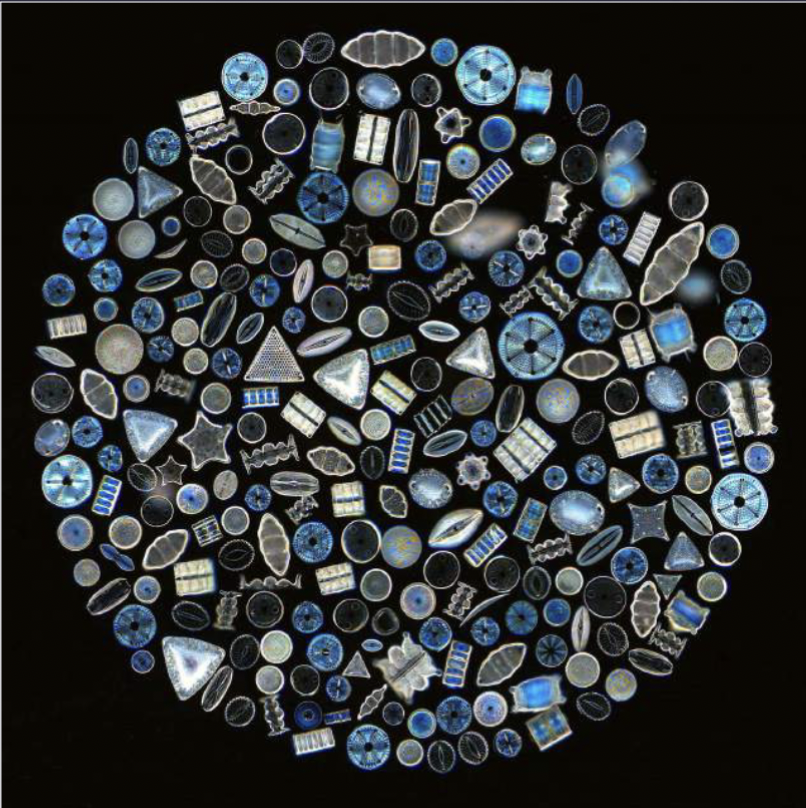
Phytoplankton global distribution
Abundance varies with location
Phytoplankton distribution corresponds to nutrient distribution in the water (upwelling areas)

Marine cyanobacteria (type of phytoplankton)
Smallest photosynthesizers
Live in nutrient-poor (oligotrophic) water between 40N and 40S
A major primary producer as 1 ml of surface seawater has 100,000 cells or more
Macroscopic algae (i.e seaweed)
Looks plant-like, but NOT a plant
Has no vascular tissue
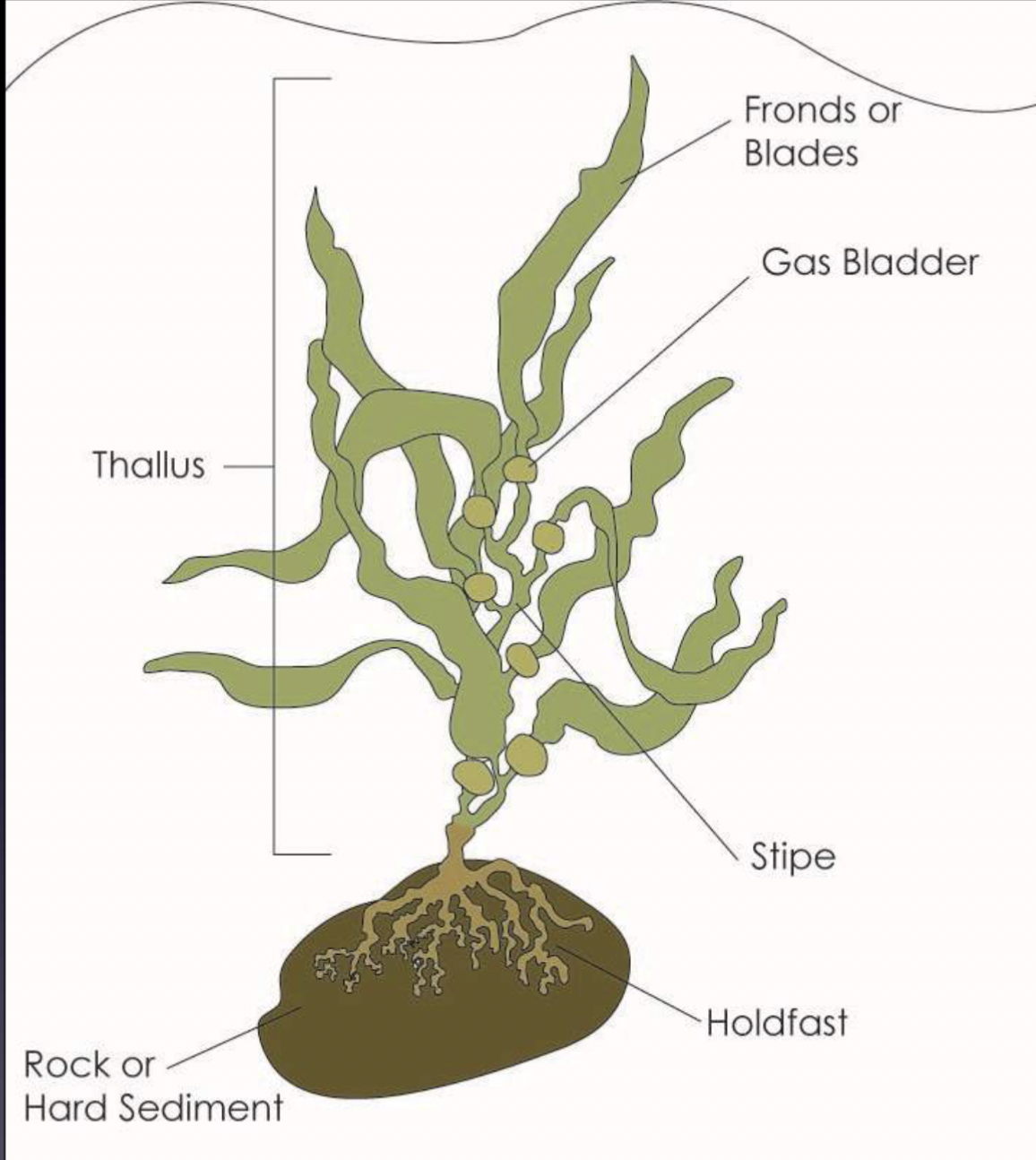
Thallus
Entire body of macroscopic algae
Holdfast
Specialized structure at base that attaches macroscopic algae to a surface
Gas bladders
Hollow, gas-filled structure on frond
Stipe
Stem-like structure (not present in all types of macroscopic algae)
Frond
Flattened structure resembling a leaf
What is “Seaweed”
Unicellular / multicellular algae – not plants (non-vascular)!
Can photosynthesize
Great diversity in size and shape
3 main classes of seaweed based on colour
Green (chlorophyta)
Red (rhodophyta)
Brown (kelp)
Where is seaweed found
Can only live in the euphotic zone and able to thrive in shallow water
Some limiting factors of temperature, nutrient supply, and substrate
Where is green seaweed (chlorophyta) found
Intertidal zones and shallow water
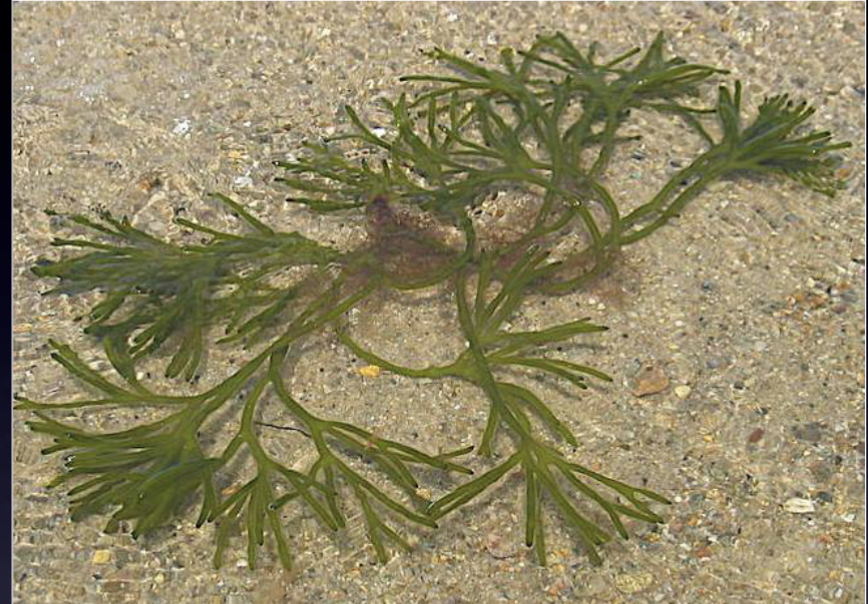
Where is red seaweed (rhodophyta) found
The most abundant type, found attached to substrate or encrusting
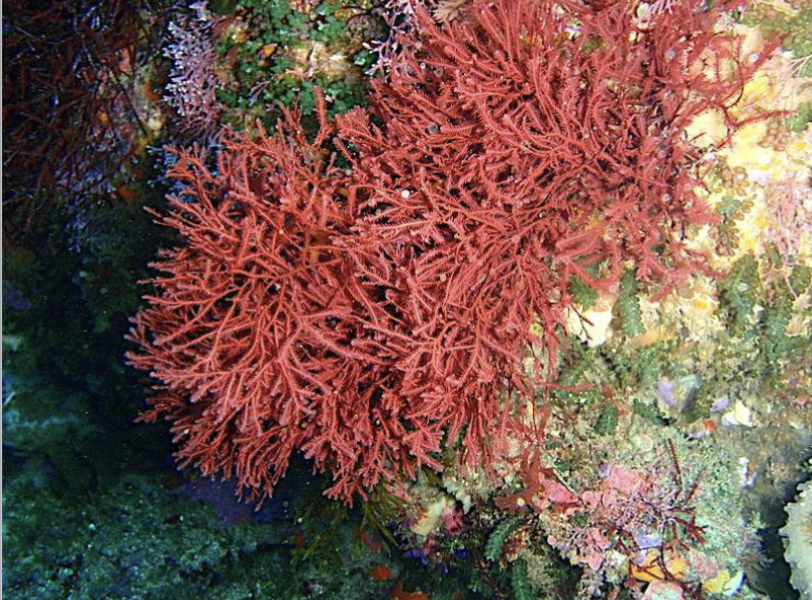
Where is brown seaweed (kelp) found
Kelp forests!
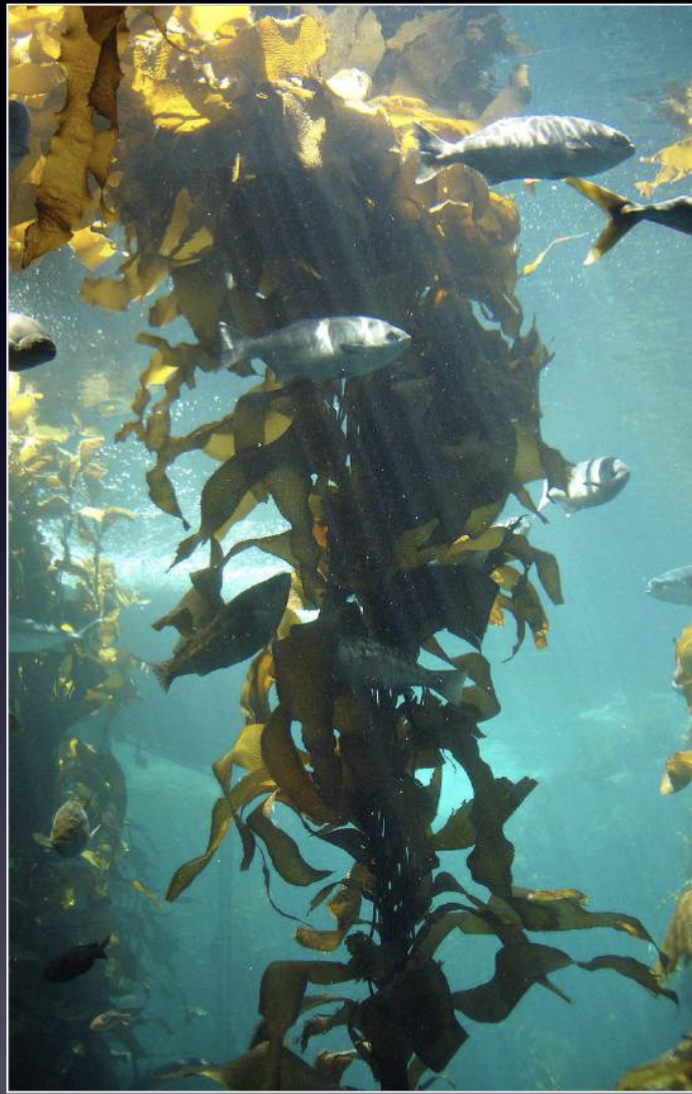
What are marine angiosperms
Marine plants that reproduce with flowers & seeds (such as sea grasses and mangroves)
These are autotrophic, vascular plants – hydrophytes or macrophytes
Mangroves
Grow in intertidal zone
Only found in lower latitudes
Can expel salt
Their unique prop root system helps maintain position in moving sediment (able to withstand rising and falling tides)
Kelp forests dominate where mangroves don’t grow
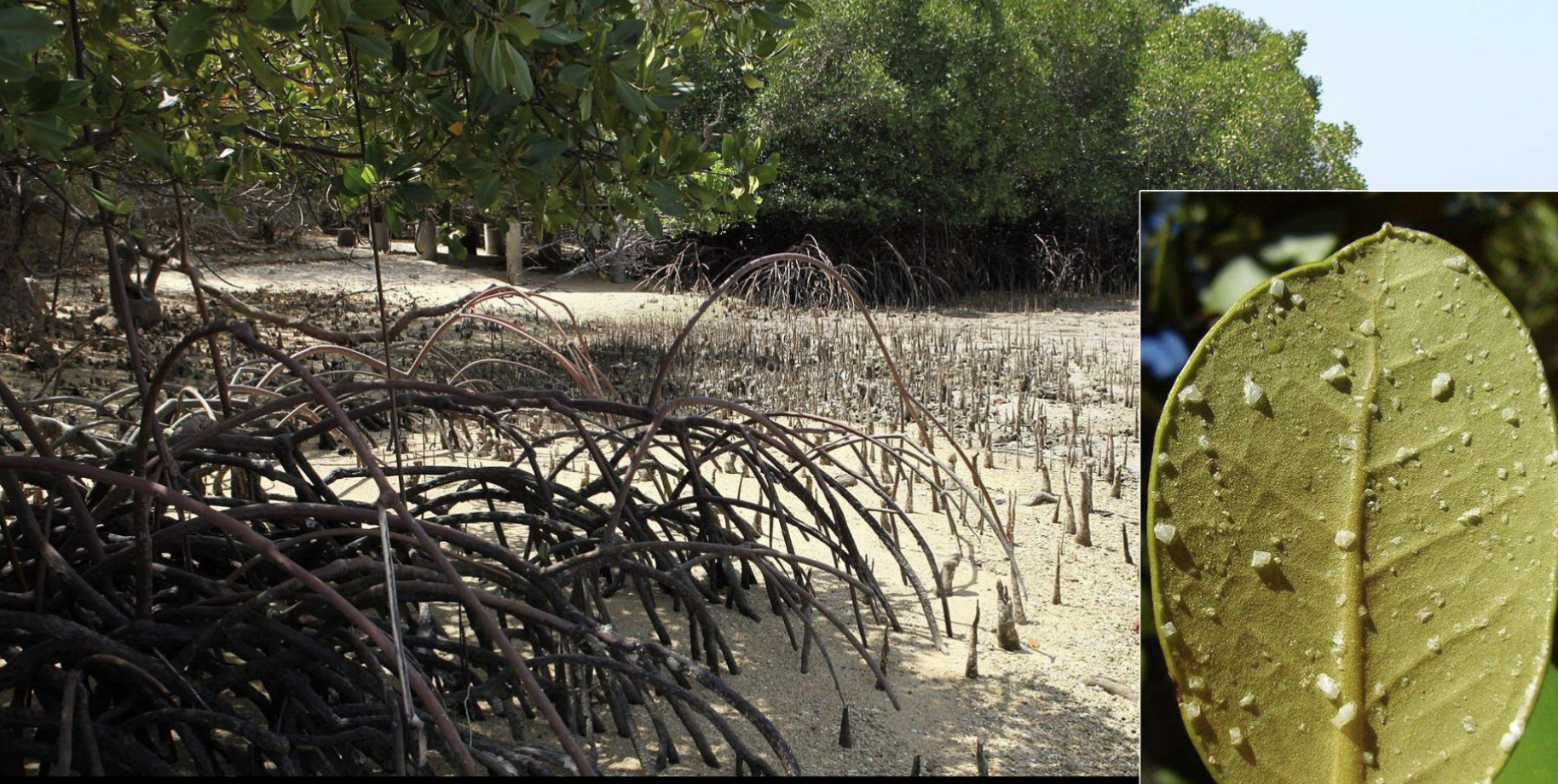
Chemosynthesis
The conversion of one or more C- containing molecules (CO2 or CH4) into organic matter using oxidation of inorganic compounds (H2, H2S or ferrous ions) as a source of energy
Occurs in aphotic zone near hydrothermal vents
May have been habitat for very first life

Riftia pachyptila
Gutless giant tube worms that have an organ containing chemosynthetic bacteria; form a symbiotic relationship